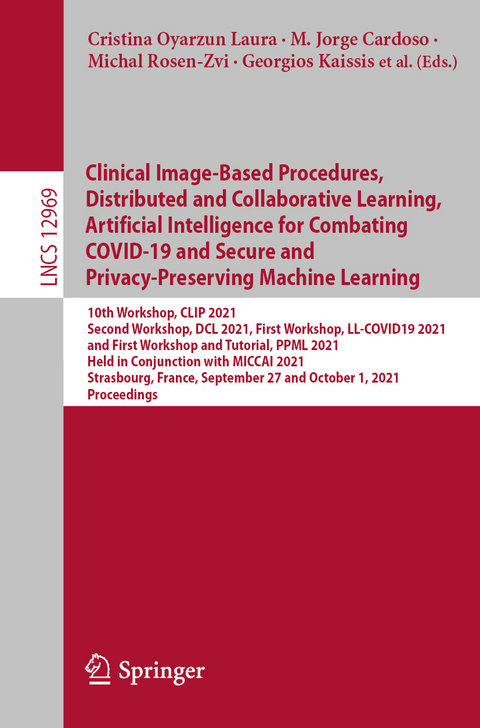
Clinical Image-Based Procedures, Distributed and Collaborative Learning, Artificial Intelligence for Combating COVID-19 and Secure and Privacy-Preserving Machine Learning
Springer International Publishing (Verlag)
978-3-030-90873-7 (ISBN)
CLIP 2021 accepted 9 papers from the 13 submissions received. It focuses on holistic patient models for personalized healthcare with the goal to bring basic research methods closer to the clinical practice.
For DCL 2021, 4 papers from 7 submissions were accepted for publication. They deal with machine learning applied to problems where data cannot be stored in centralized databases and information privacy is a priority.
LL-COVID19 2021 accepted 2 papers out of 3 submissions dealing with the use of AI models in clinical practice.
And for PPML 2021, 2 papers were accepted from a total of 6 submissions, exploring the use of privacy techniques in the medical imaging community.
Intestine segmentation with small computational cost for diagnosis assistance of ileus and intestinal obstruction.- Generation of Patient-Specific, Ligamentoskeletal, Finite Element Meshes for Scoliosis Correction Planning.- Bayesian Graph Neural Networks For EEG-based Emotion Recognition.- ViTBIS: Vision Transformer for Biomedical Image Segmentation.- Attention-guided pancreatic duct segmentation from abdominal CT volumes.- Development of the Next Generation Hand-Held Doppler With Waveform Phasicity Predictive Capabilities Using Deep Learning.- Learning from mistakes: an error-driven mechanism to improve segmentation performance based on expert feedback.- TMJOAI: an artificial web-based intelligence tool for early diagnosis of the Temporomandibular Joint Osteoarthritis.- COVID-19 Infection Segmentation from Chest CT Images Based on Scale Uncertainty.- Multi-task Federated Learning for Heterogeneous Pancreas Segmentation.- Federated Learning in the Cloud for Analysis of Medical Images- Experience with Open Source Frameworks.- On the Fairness of Swarm Learning in Skin Lesion Classification.- Lessons learned from the development and application of medical imaging-based AI technologies for combating COVID-19: why discuss, what next.- The Role of Pleura and Adipose in Lung Ultrasound AI.- DuCN: Dual-children Network for Medical Diagnosis and Similar Case Recommendation towards COVID-19.- Data imputation and reconstruction of distributed Parkinson's disease clinical assessments: A comparative evaluation of two aggregation algorithms.- Defending Medical Image Diagnostics against Privacy Attacks using Generative Methods: Application to Retinal Diagnostics.
| Erscheinungsdatum | 16.11.2021 |
|---|---|
| Reihe/Serie | Image Processing, Computer Vision, Pattern Recognition, and Graphics | Lecture Notes in Computer Science |
| Zusatzinfo | XXV, 190 p. 78 illus., 67 illus. in color. |
| Verlagsort | Cham |
| Sprache | englisch |
| Maße | 155 x 235 mm |
| Gewicht | 338 g |
| Themenwelt | Informatik ► Grafik / Design ► Digitale Bildverarbeitung |
| Informatik ► Theorie / Studium ► Künstliche Intelligenz / Robotik | |
| Schlagworte | Applications • Computer Science • computer vision • Computing Methodologies • conference proceedings • Covid-19 • Deep learning • Distributed Artificial Intelligence • Human-Computer Interaction (HCI) • Image Analysis • Image Processing • image reconstruction • Image Segmentation • Informatics • Learning Systems • machine learning • Medical Images • Network Protocols • Neural networks • privacy-preserving protocols • Research • Security and Privacy • Signal Processing • Translational research • Ultrasound |
| ISBN-10 | 3-030-90873-9 / 3030908739 |
| ISBN-13 | 978-3-030-90873-7 / 9783030908737 |
| Zustand | Neuware |
| Haben Sie eine Frage zum Produkt? |
aus dem Bereich


